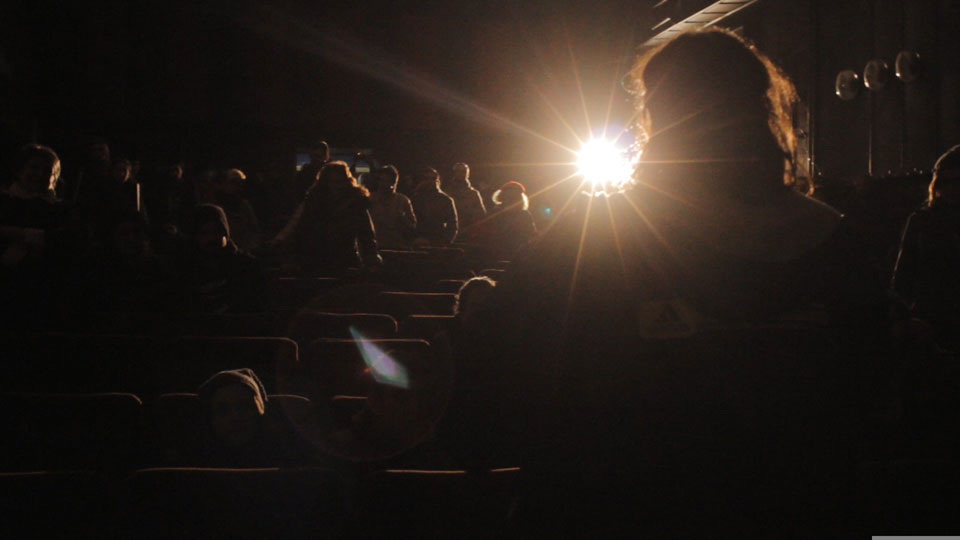
LOS ANGELES—If “audacity in cinema” is the theme of this year’s South East European Film Festival, then the Serbian documentary Occupied Cinema is among the 14th annual SEEfest’s most audacious films. Following the circa 1990 collapse of a form of socialism in former Yugoslavia, along with civil and ethnic wars, a wave of privatization swept Serbia and the other former Yugoslav republics. State-owned nationalized properties were sold off to private owners (often, according to the film, at pennies on the dollar), including a chain of movie theaters in Belgrade, Serbia’s capital.
Around 2014 activists—who may have been inspired by America’s Occupy Movement—took over the Zvezda, an arthouse cinema in Belgrade. Most of the theater’s occupiers were born after the 1980 death of Marshal Tito, the World War II leftwing partisan who had united the disparate nationalities of what was Yugoslavia. But like Tito, the occupiers seemed motivated by collectivist and other lofty lefty ideals. Among other things, the idealistic students and other participants turned the empty, crumbling venue into a cultural center, presenting hundreds of movie screenings, concerts, panel discussions—plus endless meetings and debates over what the militants were doing, why and what their goals were. Resisting the reactionary tide of privatization was also a key part of their progressive agenda.
Participatory, direct democracy can be messy, as everyone gets their say in how the Zvezda should be operated and for what purposes. Whereas unity and solidarity seem to be required, the occupiers often sharply disagree with one another, although they do so vocally, not violently (at least onscreen). As the slogan goes, “This is what democracy looks like.” Like what? Disagreement ad infinitum?
At one point, Alexis Tsipras, the socialistic prime minister of neighboring Greece, visits the Zvezda in an act of solidarity. However, one of the more extreme occupiers denounces Tsipras, who was elected on the left-leaning Syriza Party ticket but eventually acquiesced to the powers-that-be, as an agent of “American imperialism.”
In another vignette caught on camera, a homeless woman insists that she too should have access to the movie theater and its facilities for basic, economic reasons. One person’s shack is another’s chateau, and for someone living on the streets, having a roof over their head is a major improvement. This reminded me of Occupy L.A.’s encampment in front of City Hall from around 2011 to 2014: A homeless man explained to me then that the occupiers’ enclave was a step up in the world for Angelenos living without shelter. At least at the City Hall, enclosure street people had access to tents, toilets, free food, and other services. (There were also allegations of clashes between the homeless and more politically minded, idealistic members of Occupy L.A.)
In any case, as the Belgrade cinema’s residents and would-be self-managers engage in their debating society, the threat of Serbia’s iron heel of the state invading the theater and ousting the rebels hangs over their heads. Will the Serbian government allow its armed thugs to assault the theater, as the cops did nationwide under the supposedly “liberal” Obama, to violently throw the Occupy Movement out? Stay tuned and see which government is more menacing to its dissenters: Serbia’s or America’s?
The title of this documentary, directed by Senka Domanovic, seems to have a double meaning. The word “cinema” can refer to the venue where movies are screened, but also to the film medium itself. In addition to being a nonfiction chronicle of the occupation of the Zvezda, Occupied Cinema is itself an example of a film directly spawned by Serbia’s Occupy Movement. There is a disclaimer in the end credits stating that those who appear onscreen do so with their consent and the knowledge that they are being filmed for a motion picture. As such, the 88-minute, subtitled in English Occupied Cinema is a valuable document that records an intriguing moment and the movement motivating it, as politically conscious organizers tried to create a different, alternative model for how to live that’s different from the capitalistic, money-grubbing ways of existing.
At times, Occupied Cinema seemed unclear to me. The participants’ purposes and goals are not always obvious—and perhaps this is part of the point of this picture of dissent. It’s also not clear why a capitalist would purchase a chain of 16 rundown cinemas presumably from the state, only to leave them empty and fallow? Where is the profit (that golden calf capitalists always fetishize and worship as a god) in that? The goal and plans of the cinemas’ buyer are never disclosed.
I remember that when Occupy L.A. seized City Hall’s front yard and turned it into a sort of experimental Hooverville for dissidents and homeless people, it was hard for me as a journalist to just find out basic facts about the Occupy Movement. There weren’t designated press spokespersons who could keep reporters updated as to when the next demo, action, or event would take place, or notable speaker would rant and rave. If Lenin’s manifesto for organizing had been written for the Occupy Movement it would have been called: “What Is Not To Be Done” (Hahaha, I crack me up.) But seriously, any movement for change this disorganized is destined to change nothing in the material world (although, admittedly, Occupy did impact America’s consciousness, in particular adding terms like “the 1%” and “the 99%” to our political lexicon). From Belgrade to Wall Street to downtown L.A. and beyond, any cause this confused is, well, like a bad movie that needs lots of editing.
However, Occupied Cinema is actually a very good, thought-provoking film, and if it wasn’t for SEEfest presenting its North American premiere (at the ideal venue, the community-oriented Echo Park Film Center, which is collectively operated), Angeleno moviegoers would never have had the opportunity to view this worthwhile doc on the big screen, if at all. The essential role filmfests like SEEfest play in our cultural life is something that should occupy our thoughts.
And the award goes to…
The 14th South East European Film Festival Los Angeles presented 56 films over 8 days in multiple locations, with gender parity in the program. Most films were North American premieres, with four world premieres.
South East European filmmakers were celebrated with an awards ceremony at the closing night gala on May 8 at the Writers Guild Theater. The SEEfest 2019 Awards are as follows:
Best Feature Film, Grand Jury Prize: Irina (Bulgaria), director: Nadejda Koseva. Special Jury Mention: The Delegation (Albania), director: Bujar Alimani.
Bridging the Borders Award, sponsored by Cinema Without Borders: Crush My Heart (Austria), director: Alexandra Makarova.
Best Debut Feature: Irina (Bulgaria), director: Nadejda Koseva.
Best Documentary Film: Neighbors (Croatia), director: Tomislav Žaja. Special Jury Mention: ReGeneration (Bosnia & Herzegovina), director: Emir Kapetanović.
Best Cinematography in Documentary Film: Neighbors (Croatia), director of photography: Jasenko Rasol.
Best Cinematography in Feature Film: Borders, Raindrops (Bosnia & Herzegovina), director of photography: Miloš Jaćimović. Special Jury Mention: Together (Slovenia), director of photography: Marko Kočevar; and Deep Cuts (Croatia), directors of photography: Radislav Jovanov Gonzo, Dubravka Kurobasa, Luka Matic.
Best Short Fiction: Fugue (Greece), director: Laura Neri.
Best Short Documentary: Childless (Bulgaria), director: George Nicholas Zdravkov.
Best Animation Short: The Call (Romania), director: Anca Damian. Honorable Mentions: Untravel (Serbia), directors: Ana Nedeljkovic, Nikola Majdak Jr.; and Icebergs (Greece), director: Eirini Vianelli.
Audience Awards
Feature Film: Irina (Bulgaria), director: Nadejda Koseva.
Documentary Film: 49,172 (Bulgaria), director: Plamen Petkov.
For more about the South East European Film Festival see here.












Comments